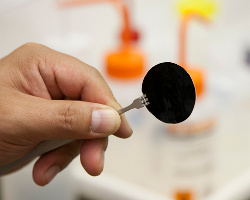
Examples that have previously been reported on InterNanoinclude silver nanowires, carbon nanotubes, and woven nanofibers. Single walledcarbon nanotubes (SWNTs) for example have exhibited unprecedented properties interms of water transport with size dependent ion and heavy metal exclusion onthe order of 1-2 nm. SWNTs are also the foundation for wearable protectivesuites for first responders, that enablebreathability while also enabling other functionalities such as the sensing of chem/biothreats, isolating the wearer from the threat, and then providing breathabilityonce the threat has been mitigated. While such functionally reactive protectivegarments are still in development, nearer term technology impact utilizing highsurface area nanoporous or nanofiber materials are already at hand.
One of the the challenges for personal protection equipment (PPE) garments is the need toprovide breathability. Recently, nanofibers have been demonstrated to providecompetitive or superior performance for filtration of pollutants and possibletoxic particulate matter for protective masks. “R&D Magazine reports theuse of nanofiber face masks developed by Hong Kong Polytechnic University totrap the most harmful air pollutants at PM 2.5 (2.5 microns) and smaller. Dr.Leung and his team have developed effective filters that also allow adequateair-flow for respiration.”, reports Alan Rae in a recent expert commentary toInterNano.
http://www.rdmag.com/news/2014/05/multilayer-nanofiber-face-mask-helps-combat-pollution
Theuse of nanofibers in a textile-like filter allows sufficient air-flow forrespiration for continuous wearability while demonstrating effective filtrationof particulate to the micron scale, and partial filtration of particles down tothe 100 nm scale. Further developments in this area would anticipateimprovements to enable effective screening of nanoscale pollutants. In thisparadigm, nanomaterials provide a significant societal benefit addressing theneed for both workforce and public safety while enabling PPE concepts withunique and superior performance. In addition, scaled nanomanufacturing willultimately affect new markets for application of such materials that requirechallenging form factors, assembly, or integration with other functionalities.The NNN looks forward to future reporting of such technology demonstrations andcommercialization.
